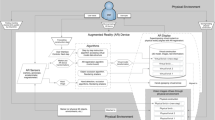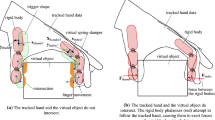Abstract
Modeling tools typically have their own interaction methods for combining virtual objects. For realistic composition in 3D space, many researchers from the fields of virtual and augmented reality have been trying to develop intuitive interactive techniques using novel interfaces. However, many modeling applications require a long learning time for novice users because of unmanageable interfaces. In this paper, we propose two-handed tangible augmented reality interaction techniques that provide an easy-to-learn and natural combination method using simple augmented blocks. We have designed a novel interface called the cubical user interface, which has two tangible cubes that are tracked by marker tracking. Using the interface, we suggest two types of interactions based on familiar metaphors from real object assembly. The first, the screw-driving method, recognizes the user’s rotation gestures and allows them to screw virtual objects together. The second, the block-assembly method, adds objects based on their direction and position relative to predefined structures. We evaluate the proposed methods in detail with a user experiment that compares the different methods.
















Similar content being viewed by others
Explore related subjects
Discover the latest articles and news from researchers in related subjects, suggested using machine learning.References
Anderson TW, Darling DA (1952) Asymptotic theory of certain ‘goodness of fit’ criteria based on stochastic processes. Ann Math Stat 23:193–212
ARToolKit, http://www.hitl.washington.edu/artoolkit
Butterworth J, Davidson A, Hench S, Olano M (1992) 3DM: a three dimensional modeler using a head mounted display. In: International symposium on interactive 3D graphics 1992, pp 135–138
Camarata K, Do EY, Johnson BR, Gross MD (2002) Navigational blocks: navigating information space with tangible media. In: Proceeding of the 7th international conference on intelligent user interface, 2002, pp 31–38
Connacher H, Jayaram S, Lyons K (1995) Virtual assembly design environment. In: Proceedings of 1995 computers in engineering conference, Boston, MA
Couture N, Riviere G, Legardeur J (2008) Tangible user interface integration in engineering. Int J Interact Des Manuf 2(3):175–182
De Sa AG, Zachmann G (1999) Virtual reality as a tool for verification of assembly and maintenance processes. Comput Graphics 23:389–403
Depaulis F, Couture N, Legardeur J, Garreau L (2005) A reusable methodology based on filters in order to define relevant tangible parts for a TUI. In: Proceedings of electronic imaging science and technology, stereoscopic displays and virtual reality systems XII electronic imaging 2005, vol 5664, pp 530–539
Fiala P, Adamo-Villani N (2005) ARpm: an augmented reality interface for polygonal model-ing. In: Proceeding of the 4th international symposium on augmented reality, 2005, pp 196–197
Gaulin S (1992) Evolution of sex differences in spatial ability. Yearb Phys Anthropol 35:125–151
Gribnau MW, Hennessey JM (1998) Comparing single-and two-handed 3D input for a 3D object assembly task. In: Conference on human factors in computing systems, 1998
Guiard Y (1987) Symmetric division of labor in human skilled bimanual action: the kinematic chain as a model. J Motor Behav 19(4):486–517
Irawati S, Green S, Billinghurst M, Duenser A (2006) An evaluation of an augmented reality multimodal interface using speech and paddle Gestures. Lecture notes in computer science Springer Berlin Heidelberg, 2006, vol 4282, pp 272–283
Ishii H, Ullmer B (1997) Tangible bits: towards seamless interfaces between people, bits and atoms. In: Proceedings of the ACM conference on human factors in computing systems, 1997, pp 234–241
Jayaram S, Connacher H, Lyons K (1997) Virtual assembly using virtual reality techniques. Computer-Aided Design, 1997, vol 29(8)
Kato H, Billinghurst M, Poupyrev I (2001) Tangible augmented reality. In: SIGGRAPH 2001 Course, Notes 21, 2001
Kato H, Tachibana K, Tanabe M, Nakajima T (2003) A city-planning system based on augmented reality with a tangible interface. In: Proceedings of the 2nd international symposium on mixed and augmented reality, 2003, pp 340–341
Kiyokawa K, Takemura H, Katayama Y, Iwasa H, Yokoya N (1996) VLEGO: a simple two-handed modeling environment based on toy blocks. ACM VRST, 1996, pp 27–34
LDD Lego Digital Designer, http://ldd.lego.com
Lee GA, Kim GJ (2009) Immersive authoring of tangible augmented reality content: a user study. J Visual Lang Comput 20(2):61–79
Lersithichai S, Seegmiller M (2002) CUBIK: a bi-directional tangible modeling interface. In: Conference on human factors in computing systems, 2002, pp 756–757
Olkin I, Ghurye SG, Hoeffding W, Madow WG, Mann HB (1960) Robust tests for equality of variances. In: Contributions to probability and statistics, Chap. 25, Stanford University Press, Stanford, CA
OSG Open Scene Graph: http://www.openscenegraph.org/projects/osg
Park JY, Lee JW (2004) Tangible augmented reality modeling. Lecture Note in Computer Science Springer Berlin Heidelberg, 2004, pp 254–259
Park Y, Lepetit V, Woo W (2008) Multiple 3D object tracking for augmented reality. In: Proceedings of the 7th international symposium on mixed and augmented reality, 2008 (ISMAR 2008), pp 117–120
Poupyrev I, Tan DS, Billinghurst M, Kato H, Regenbrecht H, Tetsutani N (2002) Developing a generic augmented-reality interface. IEEE Comput 35(3):44–50
Reuter P, Rivière G, Couture N, Sorraing N, Espinasse L, Vergnieux R (2007) ArcheoTUI—a tangible user interface for the virtual reassembly of fractured archeological objects. In: VAST2007: Proceedings of the 8th EuroGraphics international symposium on virtual reality, archaeology and cultural heritage, 2007, pp 15–22
Wang X, Kotranza A, Quarles J, Lok B, Allen D (2005) A pipeline for rapidly incorporating real objects into a mixed environment. In: Proceedings of the 4th international symposium on mixed and augmented reality, 2008 (ISMAR 2008), pp 170–173
Watanabe R, Itoh Y, Asai M, Kitamura Y, Kishino F, Kikuchi H (2004) The soul of Active Cube: implementing a flexible, multimodal, three-dimensional spatial tangible interface. In: Proceedings of the international conference on advances in computer entertainment technology, 2004, pp 173–180
Yonemoto S, Yotsumoto T, Taniguchi R (2007) Virtual object manipulation using physical blocks. In: Proceedings of the 11th international conference information visualization, 2007, pp 781–785
Zhou ZY, Cheok AD, Tedjokusumo H, Omer GS (2008) wIzQubesTM–A novel tangible interface for interactive storytelling in mixed reality. Int J Virtual Real 7(4):9–15
Author information
Authors and Affiliations
Corresponding author
Additional information
This research is supported by Ministry of Culture, Sports and Tourism (MCST) and Korea Creative Content Agency (KOCCA) in the Culture Technology (CT) Research & Development Program 2009.
Rights and permissions
About this article
Cite this article
Lee, H., Billinghurst, M. & Woo, W. Two-handed tangible interaction techniques for composing augmented blocks. Virtual Reality 15, 133–146 (2011). https://doi.org/10.1007/s10055-010-0163-9
Received:
Accepted:
Published:
Issue Date:
DOI: https://doi.org/10.1007/s10055-010-0163-9




